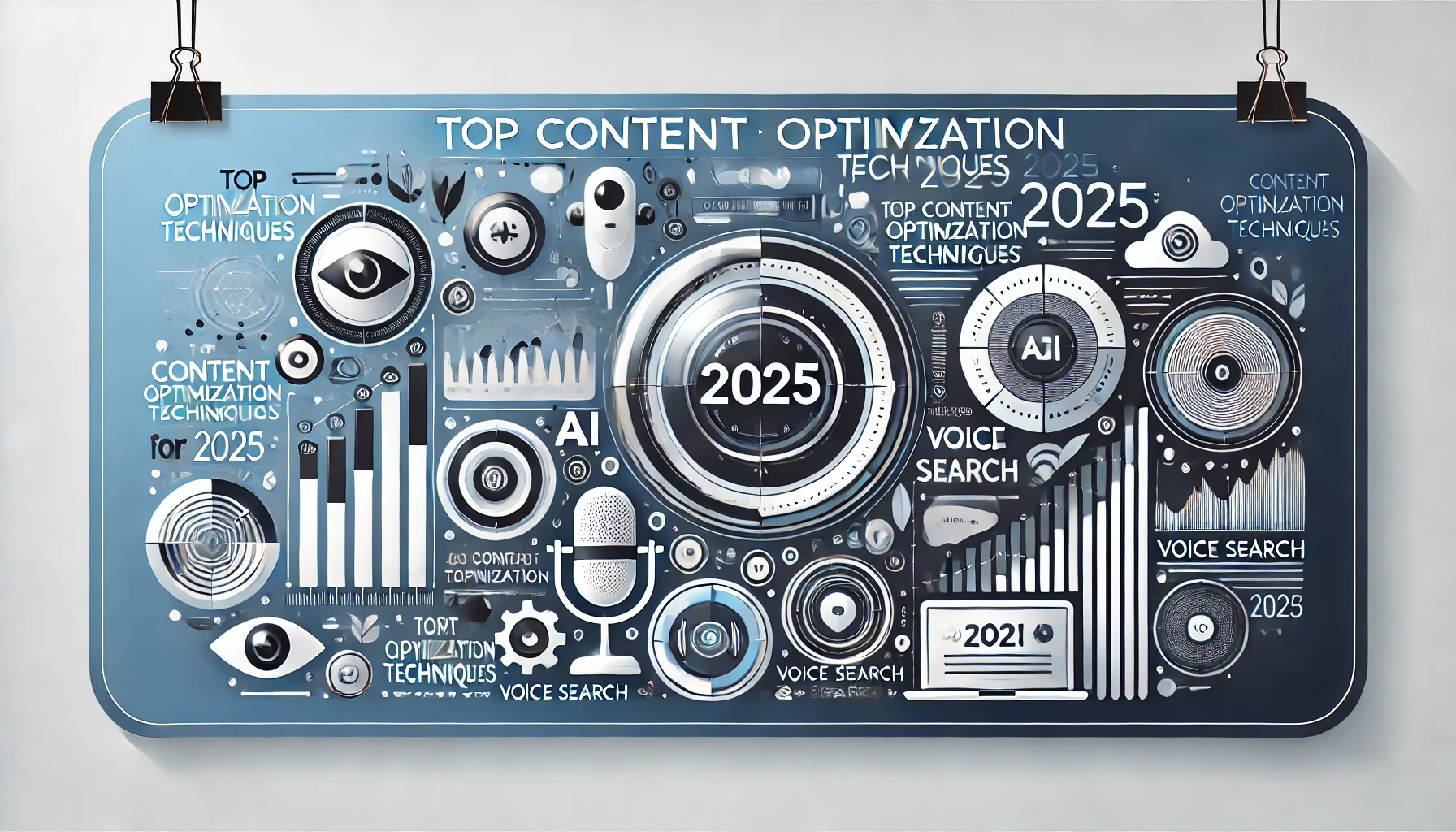
08 Nov Top Content Optimization Techniques for 2025
Top Content Optimization Techniques for 2025
As we head into 2025, the digital marketing landscape continues to evolve at a rapid pace. Content optimization remains a key strategy for businesses aiming to stay competitive, increase visibility, and engage their audiences effectively. Here are the top content optimization techniques to implement in 2025.
1. Embrace AI-Powered Content Tools
Artificial Intelligence (AI) has become an integral part of content creation and optimization, making it easier for marketers to create engaging and effective content. Tools like Jasper, SurferSEO, and others have revolutionized how we approach keyword density, search intent, and readability analysis.
How to Use AI Tools: Integrate these tools into your content workflow by:
- Using them to identify trending keywords and topics.
- Generating content outlines and drafts based on real-time data.
- Optimizing existing content with keyword suggestions and readability improvements.
Pro Tip: Use AI-generated insights as a starting point and apply a human touch to maintain authenticity and connection.
2. Optimize for Voice Search
Voice search continues to grow as smart devices become more common. By 2025, it’s estimated that more than 50% of households will own smart speakers, and users will increasingly turn to voice-activated search for answers.
Voice Search Techniques:
- Optimize content with conversational language and long-tail keywords that match how people naturally speak.
- Structure your content in a Q&A format, making it more likely to be featured in voice search snippets.
- Use schema markup to enhance search engine understanding of your content.
Example: Instead of writing “best running shoes,” try phrasing your content as “What are the best running shoes for marathon training?”
3. Prioritize User Experience (UX)
Search engines have emphasized UX for years, and 2025 will be no different. Elements like page load speed, mobile responsiveness, and intuitive navigation play a huge role in user satisfaction and content ranking.
Optimization Tips:
- Use tools like Google PageSpeed Insights and Lighthouse to analyze and improve page load speeds.
- Ensure that your site design is mobile-friendly, as mobile users continue to outnumber desktop users.
- Implement interactive features like clickable tabs, collapsible lists, and dynamic content to engage users and keep them on the page longer.
Future UX Standards: Keep an eye on potential new accessibility requirements or interactive features that could set new benchmarks for UX.
4. Focus on E-E-A-T (Experience, Expertise, Authoritativeness, Trustworthiness)
Google’s E-E-A-T (Experience, Expertise, Authoritativeness, Trustworthiness) has become more significant, especially with the shift towards high-quality, reliable content. Content that demonstrates these attributes is more likely to rank well.
E-E-A-T Strategies:
- Collaborate with subject-matter experts for content creation to enhance credibility.
- Link to authoritative sources to build trust.
- Regularly update your content to keep it current and accurate.
Case Study: Websites like WebMD and Investopedia thrive because they prioritize expert contributions and transparency, solidifying their authority.
Actionable Insight: Implement author bios with credentials and publish original research or case studies to demonstrate expertise.
5. Use Data-Driven Insights for Content Planning
In the world of content marketing, data is king. By 2025, using data analytics to understand audience behavior and preferences will be a must-have skill. Data-driven insights allow you to tailor content that resonates more with your target audience.
How to Implement:
- Utilize tools like Google Analytics 4 to analyze audience behavior, demographics, and engagement metrics.
- Apply heatmaps and session recordings to see how users interact with your content and identify areas for improvement.
- Conduct A/B testing on headlines, images, and CTAs to find the most effective elements.
Benefits: This data-backed approach ensures that your content is not only relevant but also optimized for maximum impact.
6. Integrate Interactive Content
Interactive content will dominate content marketing in 2025. Unlike static articles, interactive content like quizzes, polls, and interactive infographics encourages users to engage directly with the material.
Why It Works: Interactive content has been shown to boost dwell time and increase user engagement, which can positively impact SEO metrics.
Ideas for Implementation:
- Create interactive quizzes relevant to your industry (e.g., “What Type of Marketing Strategy Suits Your Business Best?”).
- Design polls or surveys to gather feedback and increase time spent on the page.
- Use interactive calculators or planning tools for specific industries, such as finance or travel.
SEO Benefits: Search engines reward pages with lower bounce rates and higher engagement, and interactive content checks both boxes.
7. Optimize for Multilingual and Multicultural Audiences
The internet is a global marketplace, and catering to multilingual and multicultural audiences is more important than ever. As businesses expand globally, content must reflect the linguistic and cultural nuances of diverse audiences.
Strategies:
- Use translation plugins like Weglot or WPML to create multilingual content without sacrificing SEO.
- Adapt content to reflect cultural preferences and sensibilities, ensuring relevancy and relatability.
- Research local keywords and tailor your SEO strategy to match regional trends.
Pro Tip: Don’t rely solely on automated translations. Ensure content is reviewed by native speakers for accuracy and cultural appropriateness.
8. Invest in Visual and Video Content Optimization
Visual and video content has become essential for engaging modern audiences. As attention spans shrink, visuals offer a quick and effective way to convey messages.
Why It Matters: By 2025, video is predicted to account for 82% of all online traffic, making video SEO a critical aspect of content optimization.
Techniques:
- Optimize images with alt text, descriptive filenames, and appropriate compression to maintain page speed.
- Use high-quality thumbnails and keyword-rich descriptions for videos.
- Provide transcripts for video content to improve accessibility and help search engines index the content.
Emerging Formats: Short-form video content, such as Reels or TikToks, will continue to be effective for attracting attention, especially for younger demographics.
Conclusion
Content optimization in 2025 is about embracing the latest trends while maintaining best practices that drive results. Leveraging AI, optimizing for voice search, prioritizing UX, and implementing E-E-A-T principles will help ensure your content remains visible and authoritative. Integrating interactive and multilingual content will expand your reach, while data-driven strategies and visual content will enhance user engagement. By staying proactive and adaptable, your content strategy can thrive and continue to deliver results in an ever-changing digital landscape.
Ready to elevate your content strategy for 2025? Contact us for a consultation and discover how we can help optimize your digital presence for the upcoming year and beyond.


